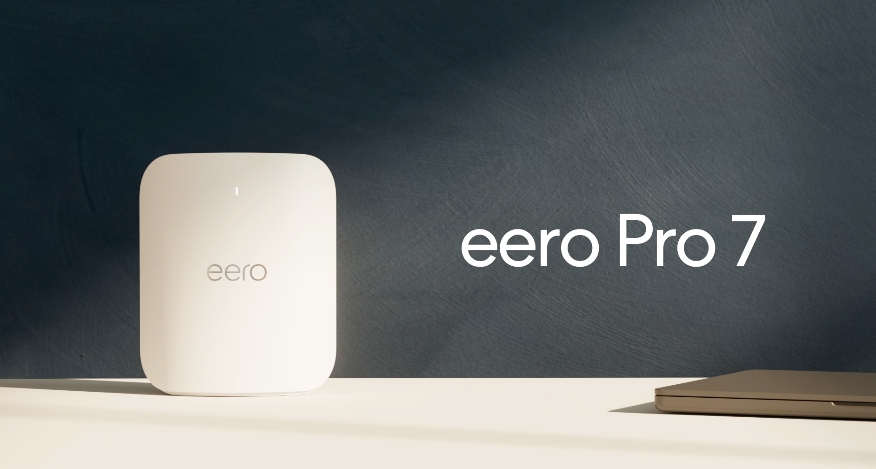Eero launches new Wi-Fi 7 mesh routers starting at $169
The Eero 7 and Eero Pro 7 max out at $349 and $699, respectively, for tri-node systems.

Following the launch of the Eero Max 7 mesh router in late 2023 and the Eero Outdoor 7 in late 2024, Eero is delivering two new products that leverage the improved capabilities of the Wi-Fi 7 standard. The most important thing to know about these new products is that they come with a much lower starting price than the Eero Max 7, which launched at $599 for a single wireless node and $1,699 for a complete three-node system (now $479, $919, and $1,359 for single-, dual-, and tri-node systems). The new Eero Pro 7 and Eero 7 undercut those prices by hundreds of dollars.
The Eero Pro 7 is a tri-band solution (2.4 GHz, 5 GHz, 6 GHz) that delivers wireless speeds up to 3.9 Gbps (compared to 4.3 Gbps for the Eero Max 7). Whereas the Eero Max 7 gives you two 10 GbE ports and two 2.5 GbE ports, the Eero Pro 7 only features two 5 Gbps ports per node. The Eero Pro 7 also takes a step back in its wireless footprint, covering up to 2,000 square feet instead of 2,500 square feet for a single node. If you opt for a tri-node setup, maximum coverage expands to 6,000 feet.
| Row 0 - Cell 0 | Eero 7 | Eero Pro 7 | Eero Max 7 |
Wi-Fi Standard | Wi-Fi 7 | Wi-Fi 7 | Wi-Fi 7 |
Wireless Bands | 2.4 GHz, 5 GHz | 2.4 GHz, 5 GHz, 6 GHz | 2.4 GHz, 5 GHz, 6 GHz |
Maximum Wi-Fi Speeds | 1.8 Gbps | 3.9 Gbps | 4.3 Gbps |
LAN Ports | 2x 2.5 GbE | 2x 5 GbE | 2 x 2.5 GbE, 2 x 10 GbE |
Starting Price (Single Node) | $169 | $299 | $599 |
These performance downgrades shouldn’t be too much of a hindrance for most consumers. In addition, the specs downgrade also means that Eero was also able to make some significant cuts to pricing. The Eero Pro 7 costs just $299 for a single node, while dual- and tri-node options are $549 and $699, respectively. That makes the Eero Pro more cost-competitive with similar entries from value-priced brands such as TP-Link.

While a $299 starting price is undoubtedly more palatable, some customers won’t mesh support at an even lower price point. That’s where the Eero 7 comes in, with a starting price of just $169. Of course, there are plenty of compromises to achieve that low price. While the Eero Max 7 and Eero Pro 7 are tri-band solutions, the Eero 7 is a dual-band router (2.4 GHz and 5 GHz). You miss out on the performance-laced 6 GHz band but still get to take advantage of Wi-Fi 7 technologies like 4K-QAM and multi-link operation (MLO). You’re limited to just two 2.5 GbE ports per node, and wireless speeds max out at 1.8 Gbps, less than half of what’s possible with the Eero Pro 7. However, you still get up to 2,000 square feet of coverage with a single wireless node and up to 6,000 square feet with a tri-node setup. A two-node system costs $279, and a tri-node system costs just $349.
The Eero Pro 7 and Eero 7 are available for pre-order today from Amazon and will ship in the United States on February 26. Shipments will commence in Canada on March 26.
Get Tom's Hardware's best news and in-depth reviews, straight to your inbox.

Brandon Hill is a senior editor at Tom's Hardware. He has written about PC and Mac tech since the late 1990s with bylines at AnandTech, DailyTech, and Hot Hardware. When he is not consuming copious amounts of tech news, he can be found enjoying the NC mountains or the beach with his wife and two sons.
-
bill001g What a scam. The key reason wifi6e and wifi7 can run faster is that they can use 160 or even 320mhz radio channel in the case if wifi7. You have massive issues using 160mhz radio bands on 5ghz and there is no way to run 320mhz.Reply
They just want to pretend this is wifi7. Sure it might use the more dense data encodings but these tend to work very poorly if you are not in the same room as the router.
Not having support for the 6ghz radio band makes this almost telling a lie to call it wifi7. -
Blastomonas Who are Eero? Sounds like one of those Knock off companies on Amazon. The ones that sound like some Chinese dude got hold of an English dictionary and just mashed some random words together..Reply -
txfeinbergs Reply
Eero has been around for over 10 years and was started as an independent AMERICAN company. Amazon did buy them out. You might want to do some research before making fact-lacking comments. Their products are very highly rated (and MUCH better than TP-Link which is pretty much crap and is a Chinese company).Blastomonas said:Who are Eero? Sounds like one of those Knock off companies on Amazon. The ones that sound like some Chinese dude got hold of an English dictionary and just mashed some random words together.. -
HideOut Reply
Yep, but if you click on the link toms hardware gets a cut!bill001g said:What a scam. The key reason wifi6e and wifi7 can run faster is that they can use 160 or even 320mhz radio channel in the case if wifi7. You have massive issues using 160mhz radio bands on 5ghz and there is no way to run 320mhz.
They just want to pretend this is wifi7. Sure it might use the more dense data encodings but these tend to work very poorly if you are not in the same room as the router.
Not having support for the 6ghz radio band makes this almost telling a lie to call it wifi7.
At least the $299 one is more a real WiFi 7 setup. Finally not $700 -
Blastomonas Reply
Chill your beans. Twas a jest. However, they have very limited international recognition. They are no Netgear or Asus.txfeinbergs said:Eero has been around for over 10 years and was started as an independent AMERICAN company. Amazon did buy them out. You might want to do some research before making fact-lacking comments. Their products are very highly rated (and MUCH better than TP-Link which is pretty much crap and is a Chinese company).
For the record, I wouldn't touch Tp-link. -
2Be_or_Not2Be Reply
The article clearly says the Eero Pro 7 is tri-band (2.4, 5, & 6GHz). Why do you say it doesn't have support for 6GHz?bill001g said:What a scam. The key reason wifi6e and wifi7 can run faster is that they can use 160 or even 320mhz radio channel in the case if wifi7. You have massive issues using 160mhz radio bands on 5ghz and there is no way to run 320mhz.
They just want to pretend this is wifi7. Sure it might use the more dense data encodings but these tend to work very poorly if you are not in the same room as the router.
Not having support for the 6ghz radio band makes this almost telling a lie to call it wifi7. -
TJ Hooker Reply
Further down in the article:2Be_or_Not2Be said:The article clearly says the Eero Pro 7 is tri-band (2.4, 5, & 6GHz). Why do you say it doesn't have support for 6GHz?
"That’s where the Eero 7 comes in, with a starting price of just $169. Of course, there are plenty of compromises to achieve that low price. While the Eero Max 7 and Eero Pro 7 are tri-band solutions, the Eero 7 is a dual-band router (2.4 GHz and 5 GHz). You miss out on the performance-laced 6 GHz band " -
bill001g Reply
This type of comment is exactly why I say it is a scam. They are intentionally deceptive advertising a low price but assuming people are not going to read the fine print. They see wifi7 and think all devices are that say that are the same.2Be_or_Not2Be said:The article clearly says the Eero Pro 7 is tri-band (2.4, 5, & 6GHz). Why do you say it doesn't have support for 6GHz? -
2Be_or_Not2Be Reply
Then you must have really been peeved at AT&T calling their 4G network "5Ge". :eek:;)bill001g said:This type of comment is exactly why I say it is a scam. They are intentionally deceptive advertising a low price but assuming people are not going to read the fine print. They see wifi7 and think all devices are that say that are the same.
Well, at least the dual-band model is priced the lowest. Those who might really care & actually need the
6GHz band, they'll know the difference between the base Eero 7 and the Pro/Max models. I do agree with you, though - I don't like it when companies add certain branding to devices that don't really have all of the specs. -
bill001g You would be surprised how many times I talked about the cell industry names. I think it was tmobile that started it. Everyone else was calling it 4g-lte advanced. ATT had actual 5G nodes and could easily do 1gbit but it did not penatrate walls. Nothing really new. Took many years before customers learned the difference between 4g and 4g-lte.Reply
The problem with a dual band wifi7 router is you really should be comparing it to a wifi5 802.11ac router you can get for $50 now days. The key feature is the ability to run the wider radio bands which is almost impossible to do because of all the regulation on use of the restricted radio bands on 5ghz. So you basically run 80mhz radio band which is the same as wifi5.
Sure in theory you can use QAM4096 data encoding but it has even more issue than QAM1024 that wifi6 tried to use. It only really works in the same room.
So even though they call it a dual band wifi7 router what it really compares with in true function is a $50 wifi5 router.